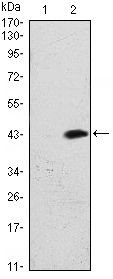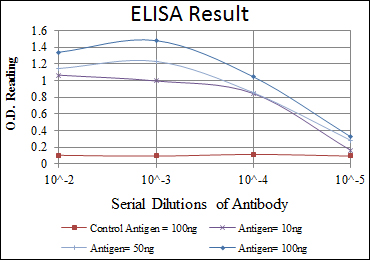Atm Monoclonal Antibody
- Catalog No.:YM0053
- Applications:WB;ELISA
- Reactivity:Human
- Target:
- Atm
- Fields:
- >>Platinum drug resistance;>>Homologous recombination;>>NF-kappa B signaling pathway;>>FoxO signaling pathway;>>Cell cycle;>>p53 signaling pathway;>>Apoptosis;>>Cellular senescence;>>Shigellosis;>>Human papillomavirus infection;>>Human T-cell leukemia virus 1 infection;>>Human immunodeficiency virus 1 infection;>>Transcriptional misregulation in cancer;>>MicroRNAs in cancer
- Gene Name:
- ATM
- Protein Name:
- Serine-protein kinase ATM
- Human Gene Id:
- 472
- Human Swiss Prot No:
- Q13315
- Mouse Swiss Prot No:
- Q62388
- Immunogen:
- Purified recombinant fragment of human Atm expressed in E. Coli.
- Specificity:
- Atm Monoclonal Antibody detects endogenous levels of Atm protein.
- Formulation:
- Liquid in PBS containing 50% glycerol, 0.5% BSA and 0.02% sodium azide.
- Source:
- Monoclonal, Mouse
- Dilution:
- WB 1:500 - 1:2000. ELISA: 1:10000. Not yet tested in other applications.
- Purification:
- Affinity purification
- Storage Stability:
- -15°C to -25°C/1 year(Do not lower than -25°C)
- Other Name:
- ATM;Serine-protein kinase ATM;Ataxia telangiectasia mutated;A-T mutated
- Molecular Weight(Da):
- 351kD
- References:
- 1. Am J Hum Genet. 2008 Aug;83(2):243-53.
2. Mol Cell. 2008 Jul 25;31(2):167-77.
- Background:
- The protein encoded by this gene belongs to the PI3/PI4-kinase family. This protein is an important cell cycle checkpoint kinase that phosphorylates; thus, it functions as a regulator of a wide variety of downstream proteins, including tumor suppressor proteins p53 and BRCA1, checkpoint kinase CHK2, checkpoint proteins RAD17 and RAD9, and DNA repair protein NBS1. This protein and the closely related kinase ATR are thought to be master controllers of cell cycle checkpoint signaling pathways that are required for cell response to DNA damage and for genome stability. Mutations in this gene are associated with ataxia telangiectasia, an autosomal recessive disorder. [provided by RefSeq, Aug 2010],
- Function:
- catalytic activity:ATP + a protein = ADP + a phosphoprotein.,disease:Defects in ATM are the cause of ataxia telangiectasia (AT) [MIM:208900]; also known as Louis-Bar syndrome, which includes four complementation groups: A, C, D and E. This rare recessive disorder is characterized by progressive cerebellar ataxia, dilation of the blood vessels in the conjunctiva and eyeballs, immunodeficiency, growth retardation and sexual immaturity. AT patients have a strong predisposition to cancer; about 30% of patients develop tumors, particularly lymphomas and leukemias. Cells from affected individuals are highly sensitive to damage by ionizing radiation and resistant to inhibition of DNA synthesis following irradiation.,disease:Defects in ATM contribute to B-cell chronic lymphocytic leukemia (BCLL). BCLL is the commonest form of leukemia in the elderly. It is characterized by the accumulation of ma
- Subcellular Location:
- Nucleus . Cytoplasmic vesicle . Cytoplasm, cytoskeleton, microtubule organizing center, centrosome . Primarily nuclear. Found also in endocytic vesicles in association with beta-adaptin. .
- Expression:
- Found in pancreas, kidney, skeletal muscle, liver, lung, placenta, brain, heart, spleen, thymus, testis, ovary, small intestine, colon and leukocytes.
- June 19-2018
- WESTERN IMMUNOBLOTTING PROTOCOL
- June 19-2018
- IMMUNOHISTOCHEMISTRY-PARAFFIN PROTOCOL
- June 19-2018
- IMMUNOFLUORESCENCE PROTOCOL
- September 08-2020
- FLOW-CYTOMEYRT-PROTOCOL
- May 20-2022
- Cell-Based ELISA│解您多样本WB检测之困扰
- July 13-2018
- CELL-BASED-ELISA-PROTOCOL-FOR-ACETYL-PROTEIN
- July 13-2018
- CELL-BASED-ELISA-PROTOCOL-FOR-PHOSPHO-PROTEIN
- July 13-2018
- Antibody-FAQs
- Products Images

- Western Blot analysis using Atm Monoclonal Antibody against HEK293 (1) and ATM-hIgGFc transfected HEK293 (2) cell lysate.




